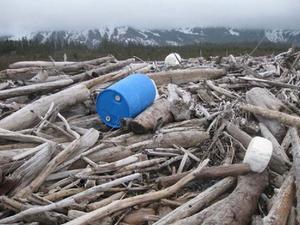TsunamisAnother wave of tsunami debris, possible invasives, to reach West Coast
Scientists monitoring incoming tsunami debris were taken aback last spring when some thirty fishing vessels from Japan washed ashore along the Pacific Northwest coast — many of them covered in living organisms indigenous to Asia. Incidence of wayward skiffs and other tsunami debris subsequently declined sharply over the summer because of seasonal shifts in the winds. Now, those winds and currents have returned to their winter-spring pattern and scientists are expecting more items to wash ashore — even though it is nearing four years since a massive earthquake and tsunami shook Japan.

Debris from tsunami washed up onto Alaskan island // Source: alaska.gov
Scientists monitoring incoming tsunami debris were taken aback last spring when some thirty fishing vessels from Japan washed ashore along the Pacific Northwest coast — many of them covered in living organisms indigenous to Asia.
Incidence of wayward skiffs and other tsunami debris subsequently declined sharply over the summer because of seasonal shifts in the winds. Now, those winds and currents have returned to their winter-spring pattern and scientists are expecting more items to wash ashore — even though it is nearing four years since a massive earthquake and tsunami shook Japan.
Blue mussels have been found on literally every boat that has washed ashore and some 200 different species overall have been documented on tsunami debris, according to John Chapman, an Oregon State University marine invasive species specialist at OSU’s Hatfield Marine Science Center.
“The crustaceans and bivalves are of particular concern because they could introduce new diseases, and compete with, displace or otherwise affect our oyster or mussel populations,” Chapman noted.
An OSU release reports that just last week, a tote with numerous mussels washed up at Seal Rock — a sign that debris will still be arriving over the next few months. Of particular concern are boats and large objects that wash ashore carrying a variety of living organisms — including some new species that were not aboard the now-infamous dock that landed on Agate Beach near Newport, Ore., in June of 2012.
“We continue to find new organisms that we have never seen before,” Chapman said. “There isn’t as much diversity aboard the Japanese fishing vessels as there was on the dock, but each new species that we haven’t seen before is a cause for concern.
“No one can predict if these new species may gain a foothold in Northwest waters — and what impacts that may have,” he added.
Chapman and OSU colleague Jessica Miller have examined roughly a dozen boats that have washed ashore from the southern Oregon coast to the central Washington coast. Most of them were similar in style — long, narrow skiffs up to thirty feet in length, with no motors. As they drift from Asia to the West Coast of North America, they pick up a variety of organisms along the way.
“We’ve been surprised at the tenacity of some of these coastal Asian organisms that are arriving on the tsunami debris because the middle of the ocean isn’t the most biologically productive place for coastal species,” Miller said.
Among some of the species the Oregon State biologists have encountered over the past year are bat stars, which are sea stars that look like they have bat wings; striped knifejaw, fish that were found alive in at least one boat; and numerous small crustaceans.
Teams of scientists from around the North Pacific region, including Chapman and Miller, have identified more than 165 species that were aboard the original dock, and another 40-50 species that were found on other debris items, including boats. The rate of incoming debris should be slowing, the researchers say, but the arrival of so many boats last spring suggests that the threat is not over.
Invasive marine species are a problem on the West Coast, where they usually are introduced via ballast water from ships. OSU’s Chapman is well aware of the issue; for several years he has studied a parasitic isopod called Griffen’s isopod that was introduced from Asia.
Griffen’s isopod infests mud shrimp in estuaries from California to Vancouver Island and is decimating their populations.
The OSU researchers are working with other scientists on the West Coast, who are attempting to genetically identify all of the species arriving on tsunami debris using genomic sampling — work led by Jon Geller of Moss Landing Marine Laboratory. Geller and his students also are collecting samples of marine life in Northwest coastal and estuary communities to look for evidence that non-native species may have established.
“We’re also doing a lot of old-fashioned looking,” Chapman said. “But new species can be difficult to identify if you aren’t searching for them directly in the first place. So we’ve identified three species that are particularly abundant in Asia, appear highly suited for invading the open coast, and would be readily apparent to searchers looking in the right place.”
These species include a hydroid, Eutima; a fly, Telmatogeton; and an amphipod crustacean, Caprella cristibrachium.
